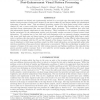Free Online Productivity Tools
i2Speak
i2Symbol
i2OCR
iTex2Img
iWeb2Print
iWeb2Shot
i2Type
iPdf2Split
iPdf2Merge
i2Bopomofo
i2Arabic
i2Style
i2Image
i2PDF
iLatex2Rtf
Sci2ools
SPIEVIP
2008
2008
Adaptive methods of two-scale edge detection in post-enhancement visual pattern processing
Adaptive methods are defined and experimentally studied for a two-scale edge detection process that mimics human visual perception of edges and is inspired by the parvo-cellular (P) and magno-cellular (M) physiological subsystems of natural vision. This two-channel processing consists of a high spatial acuity/coarse contrast channel (P) and a coarse acuity/fine contrast (M) channel. We perform edge detection after a very strong non-linear image enhancement that uses smart Retinex image processing. Two conditions that arise from this enhancement demand adaptiveness in edge detection. These conditions are the presence of random noise further exacerbated by the enhancement process, and the equally random occurrence of dense textural visual information. We examine how to best deal with both phenomena with an automatic adaptive computation that treats both high noise and dense textures as too much information, and gracefully shifts from a smallscale to medium-scale edge pattern priorities....
Computer Graphics | Edge Detection | Edge Detection Process | Edge Detection Sensitivities | SPIEVIP 2008 |
Related Content
| Added | 01 Oct 2010 |
| Updated | 01 Oct 2010 |
| Type | Conference |
| Year | 2008 |
| Where | SPIEVIP |
| Authors | Zia-ur Rahman, Daniel J. Jobson, Glenn A. Woodell |
Comments (0)

